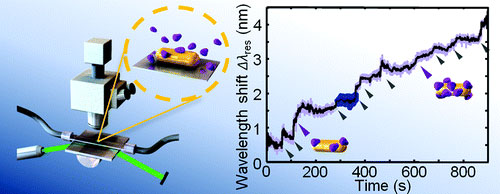| Apr 04, 2012 |
Novel nanoparticle technique for single protein observation
|
|
(Nanowerk News) Researchers must be able to recognise how proteins work so that they can understand the related biological processes that occur at the molecular level. They get this information by labelling proteins with fluorescent substances. The problem with this method, however, is that it alters the proteins and influences the biological processes under investigation.
|
|
A new study from Germany has pioneered a novel method able to observe individual proteins. Presented in the journal Nano Letters ("Single Unlabeled Protein Detection on Individual Plasmonic Nanoparticles"), the research was funded in part by the SINGLESENS ('Single metal nanoparticles as molecular sensors') project, led by Professor Carsten Sönnichsen, who in 2010 received a European Research Council (ERC) Starting Grant worth EUR 1.5 million under the EU's Seventh Framework Programme (FP7).
|
 |
| Single gold nanoparticles are utilized to detect single unlabeled proteins with extremely high temporal resolution.
|
|
Researchers at the Johannes Gutenberg University (JGU) in Mainz, Germany are responsible for the new technique. 'Our method allows live tracking of individual proteins without having to label them first,' explains Professor Carsten Sönnichsen of the Institute of Physical Chemistry at JGU, the senior author of the study,. 'We are now gaining entirely new insights into molecular processes and can see, for example, how things are constantly in motion even on the very smallest scale.'
|
|
This innovative method is based on the use of gold nanoparticles, which act as glistening nano-antennas that change their frequency (or colour) when single, unlabelled proteins are detected. 'This is an enormous leap forward technologically,' says Professor Sönnichsen. 'We have managed to achieve a very high time resolution for the observation of individual molecules.'
|
|
Researchers can now precisely observe the dynamics of a protein molecule down to the millisecond. This latest development will allow scientists to push forward with research related to proteins, particularly by tracking the fluctuation of protein population densities and by monitoring protein absorption processes in real time.
|
|
'We can see how molecules move, how they dock at particular locations, and how they fold - this has given us a window into the molecular world,' says Dr Irene Ament, a member of Sönnichsen's group and the lead author of the study.
|
|
This new technique could benefit the fields of chemistry, biology and medicine. Experts say this development is a key element in research into non-equilibrium phenomena at the molecular level.
|
|
|

